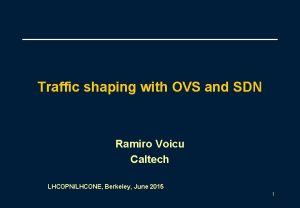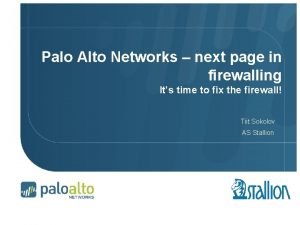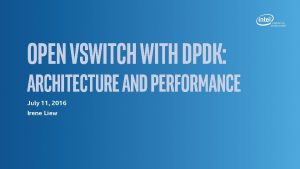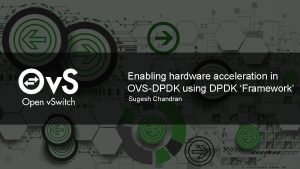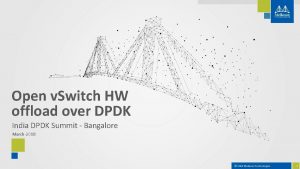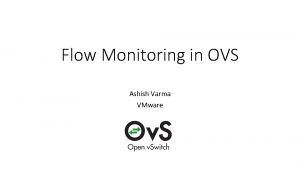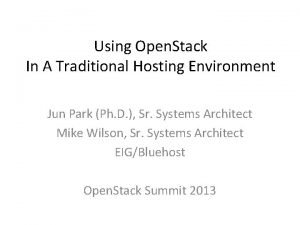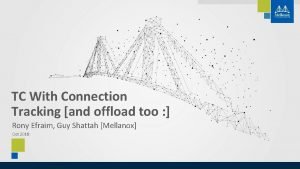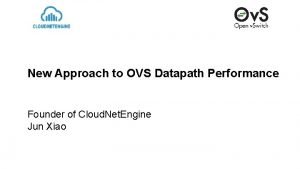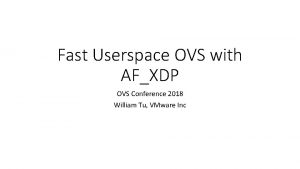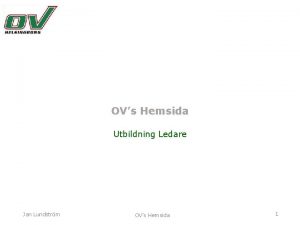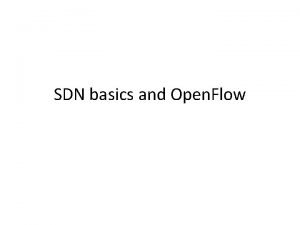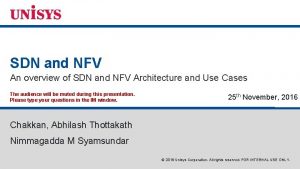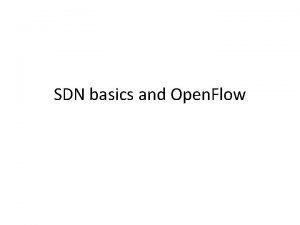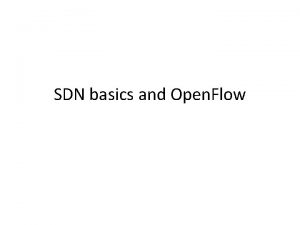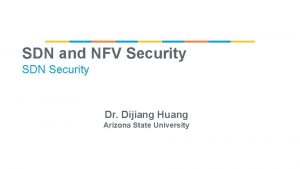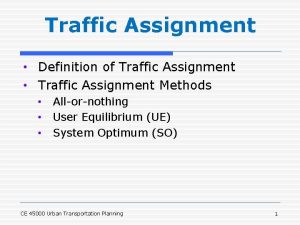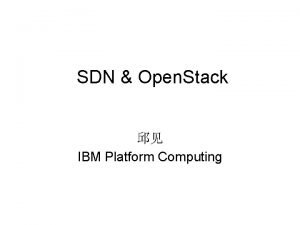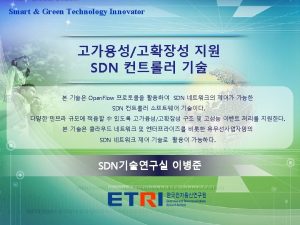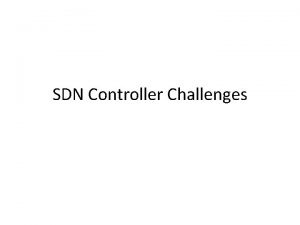Traffic shaping with OVS and SDN Ramiro Voicu





























- Slides: 29

Traffic shaping with OVS and SDN Ramiro Voicu Caltech LHCOPN/LHCONE, Berkeley, June 2015 1

SDN Controllers • “Standard” SDN controller architecture – NB: RESTfull/JSON, NETCONF, proprietary, etc – SB: OF, SNMP, NETCONF, App 1 App 2 North. Bound API SDN Controller Core South. Bound API App. N

Design considerations for SDN control plane • Even at the site/cluster level the SDN control plane should support fault-tolerance and resilience – e. g. in case one or multiple controller instances fail the entire local control plane must continue to operate • Each NE must connect to at lest two controllers (redundancy) • Scalability

SDN Controllers • NOX: – – First SDN controller C++ New protocols development Open source by Nicira in 2008 • POX – Python-based version of NOX • Ryu – Python – Integration with Open. Stack – Clustering: No SPOF using Zookeeper 4

ONOS: Open Network Operating System • “A SDN network operating system for Service Providers and mission critical networks” • Distributed core designed for High-Availability and performance (RAFT consensus algorithm) • Developed in Java - a set of OSGi modules deployed in an OSGi container (Karaf) – similar to ODL • Application Intents to NB which can be compiled on the fly in (Flow) Rules for SB – Intent: Request a service from the network without knowing how the service will be performed 5

ONOS: Open Network Operating System 6

Open. Daylight “Helium”

Open. Daylight “Helium” • Project under Linux Foundation umbrella • Well-established and very active community (very likely the biggest) • Developed in Java - a set of OSGi modules deployed in an OSGi container (Karaf) – similar to ONOS • Backed up by leading industry partners • Distributed clustering based on Raft consensus protocol • Open. Stack integration • “Helium” is the 2 nd release of ODL and supports, apart from SDN, NV (Network Virtualization) and NFV (Network Function Virtualization)

OVS Open v. Switch “Open v. Switch is a production quality, multilayer virtual switch” • Open. Flow protocol support (1. 3) • Kernel and user space forwarding engines • Runs on all major Linux distributions used in HEP[*] • NIC bonding • Fine grained Qo. S support • Ingress qdisc, HFSC, HTB • Used in a variety of hardware platforms (e. g. Pica 8) and software appliances like Mininet • Interoperates with Open. Stack • OVN (Open Virtual Network): Virtualized network “implemented on top of a tunnel-based (VXLAN, NVGRE, IPsec. , etc) overlay network” [*] For SL/Cent. OS/RH 6. x some patches had to be applied. Custom RPMs

OVS Open v. Switch Performance tests • Compared the performance of hardware versus the OVS in two cases: • Bridged network (the physical interface becomes a port in the OVS switch) • Dynamic bandwidth adjustment

Baseline performance tests (10 Ge) • • Two Sany. Bridge machines 10 Ge Mellanox cards (“back-to-back”) Stock SLC 6. x kernel Connected via Z 9 K

Baseline performance – hardware throughput (single stream) • FDT nettest (memory to memory) • • 1 TCP Stream 10 Gbps

Baseline performance (single stream) • • • FDT nettest (memory to memory) Line rate 10 Gbps CPU utilization receiver • CPU utilization sender 1 TCP Stream 95% idle

Baseline performance (multiple stream) • FDT nettest (memory to memory) CPU Usage: • Receiver: ~95% Idle • Sender: ~92% Idle (64 streams), 90% Idle (128 streams) Similar results with 8, 16, 32, 64 and 128 TCP streams • CPU utilization receiver • • • CPU utilization sender 64 TCP Streams 95% idle 93% idle

Performance tests – OVS Setup • • • Same hardware OVS 2. 3. 1 on stock SLC(6) kernel Same eth interfaces added as OVS interfaces • ovs-vsctl add port br 0 eth 5

OVS performance • • FDT nettest (memory to memory) Line rate 10 Gbps Slightly decreased performance for receiver CPU utilization receiver • CPU utilization sender 128 TCP Streams 95% idle 90% idle

Conclusions: Baseline performance tests • TCP tests with a range of multiple TCP streams varying from 1 up to 128 • Line rate in all the tests: 10 Gbps • CPU usage between 5% and 10% (normal scenario with <64 streams would be 95% CPU idle) • OVS 2. 3. 1 with stock SL/Cent. OS/RH 6. x kernel • OVS bridged interface achieved the same performance as the hardware (10 Gbps) • No CPU overhead for OVS in this scenario

OVS Dynamic bandwidth adjustment Ingress rate-limit • • OVS ingress rate-limit Adjust per interface • Based on Linux kernel ”ingress qdisc” Ingress rate limit

OVS Dynamic bandwidth adjustment Ingress rate-limit No policy 10 Gbps 7. 5 Gbps 2. 5 Gbps 10 Mbps 10 Gbps policy 9 Gbps 100 Mbps 5 Gbps

OVS Dynamic bandwidth adjustment Ingress rate-limit – Receiver CPU 1 Gbps No policy 10 Gbps 2. 5 Gbps 7. 5 Gbps Almost the same CPU Usage as without ingress policy in place 10 Gbps w/ policy 9 Gbps

OVS Dynamic bandwidth adjustment Ingress rate-limit – Sender CPU 1 Gbps No policy 10 Gbps 2. 5 Gbps 7. 5 Gbps Almost the same CPU Usage as without ingress policy in place 10 Gbps w/ policy 9 Gbps

OVS Dynamic bandwidth adjustment • • OVS egress rate-limit Based on Linux kernel: • HTB (Hierarchical Token Bucket) • HFSC (Hierarchical Fair-Service Curve) Egress rate-limit

OVS Dynamic bandwidth adjustment egress rate-limit 10 Gbps NO policy 9 Gbps 10 Gbps NO policy 11 Gbps policy 7 Gbps 500 Mbps 1 Gbps 10 Gbps policy 7. 5 Gbps 500 Mbps 2. 5 Gbps

OVS Dynamic bandwidth adjustment egress rate-limit 10 Gbps NO policy 5 Gbps 2. 5 Gbps 11 Gbps policy 10 Gbps policy 7. 5 Gbps Almost the same CPU Usage as without egress policy in place 10 Gbps NO policy 4 Gbps

OVS Dynamic bandwidth adjustment egress rate-limit– Sender CPU 10 Gbps NO policy 5 Gbps 2. 5 Gbps 11 Gbps policy 10 Gbps NO policy 4 Gbps 7. 5 Gbps Almost the same CPU Usage as without egress policy in place

Conclusions: OVS Dynamic bandwidth adjustment • Smooth egress traffic shaping up to 10 Gbps, and up to 7 Gbps for ingress • Over long RTT the ingress traffic shaping may not perform well (needs more testing), especially above 7 Gbps • The CPU overhead is negligible when enforcing Qo. S • More testing is needed: • Longer RTTs • 40 Ge? (are there any storage nodes with 40 Ge yet) • Multiple Qo. S queues for egress • reliability over longer intervals

SDN-enabled site (1) All NEs controlled by a redundant SDN control plane The entire SDN resides within the network layer

SDN-enabled site (2) OVS daemon runs on the end-host May evolve in a site with SDNcontrolled NEs OVS daemon OVS is “ready” to be deployed today without any impact on the current operations

Possible OVS benefits • The controller gets the “handle” all the way to the end-host • Traffic shaping (egress) of outgoing flows may help performance in cases where upstream switch has smaller buffers • A SDN controller may enforce Qo. S in non-Open. Flow clusters • OVS 2. 3. 1 with stock SL/Cent. OS/RH 6. x kernel • OVS bridged interface achieved the same performance as the hardware (10 Gbps) • No CPU overhead for OVS in this scenario
 Sdn ovs
Sdn ovs Ian haslam bbc wikipedia
Ian haslam bbc wikipedia Voicu popescu
Voicu popescu Palo alto traffic shaping
Palo alto traffic shaping Incomina
Incomina Intelligent traffic solutions
Intelligent traffic solutions Overeenkomst vereenvoudigde schaderegeling
Overeenkomst vereenvoudigde schaderegeling Ovs dpdk architecture
Ovs dpdk architecture Ovs acceleration
Ovs acceleration Croff milano
Croff milano Dpdk ovs offload
Dpdk ovs offload Geneve encapsulation
Geneve encapsulation Ovs monitoring
Ovs monitoring Ovs hosting
Ovs hosting Suggestednet
Suggestednet Ovs founder
Ovs founder Ovs dijon
Ovs dijon Bachillerato internacional ramiro de maeztu 2020 2021
Bachillerato internacional ramiro de maeztu 2020 2021 Cuál es el dilema que enfrenta ramiro
Cuál es el dilema que enfrenta ramiro Ramiro zepeda iriarte partido politico
Ramiro zepeda iriarte partido politico Diego ramiro
Diego ramiro Ramiro chimuris
Ramiro chimuris Ramiro duarte
Ramiro duarte Aprendizaje dirigido
Aprendizaje dirigido Ampliacion ramiro priale
Ampliacion ramiro priale Ramiro vieira
Ramiro vieira Ramiro vieira
Ramiro vieira Demand sensing and shaping
Demand sensing and shaping Shaping and planning process
Shaping and planning process No stem curl
No stem curl
